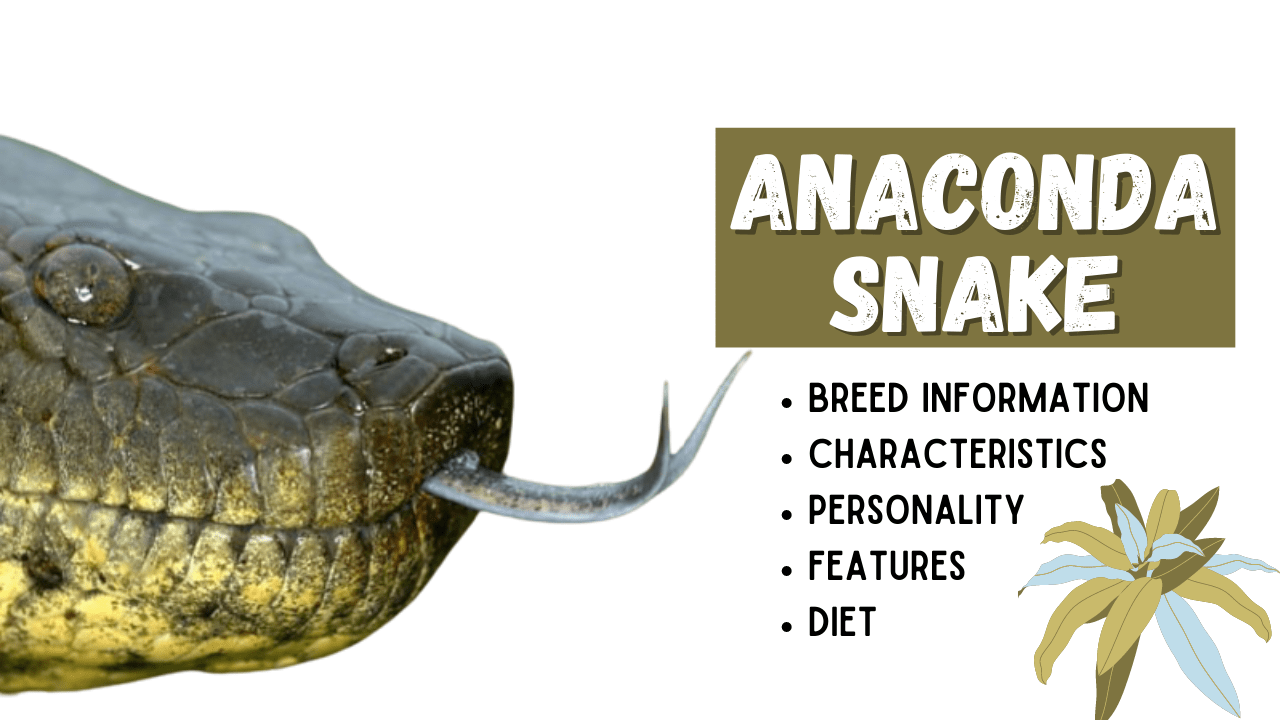
Anacondas are the largest and heaviest species of snakes. Anaconda belongs to the family Boidae and genus Eunectus. In reality, Anaconda is another name for Eunectues with 4 known species. The Green Anaconda is the most common species of Anaconda and it is said that when people refer to Anaconda, they are referring to the Green Anaconda.
Habitat of Anaconda
Anacondas are the semiaquatic snakes that are mostly found in water as they are good swimmers. Most of the Anacondas are found in South America, Brazil, Argentina, Colombia, and Ecuador.
Anacondas are found in the slow-moving streams and rivers of the tropical areas. They flourish in the humidity and heat of the rainforests. Apart from swimming, they can also move on the land and climb up the trees with limited abilities. They like to bask in the sunlight while lying on the branches over the rivers.
Physical Characteristics of the Anaconda
Anacondas have a very distinctive, thick, heavy, and sluggish appearance that makes them easily identified amongst other snakes species.
Size
Anaconda, especially the Green Anaconda is the world’s heaviest and one of the largest snake species. The size of Anacondas ranges from 17 to 40 feet and a common Anaconda weighs about 150 to 200 pounds. An Anaconda with 550 pounds weight has also been recorded. This size of the Anaconda resembles the size of a Bus.
The diameter of the Anaconda is about 12 inches. The females are usually heavier and longer than the males.
Skin
Anacondas are muscular snakes that appear with dark and thick skin. As they mostly remain in the water, their skin is loose and soft to handle water absorption. Small and smooth scales are found growing on their backs.
Anacondas also have sharp spurs on the scales of their body. The male Anacondas have large spurs than females.
Colors
The four species of Anaconda are named with their colors. Anacondas appear in green, yellow, and brown colors.
Head, Eyes, and Nostrils
The head of the Anaconda is narrow but very large. The eyes and nostrils are at the top of the head. The head remains at the surface of the water to breathe and keep an eye on the prey while the rest of the body remains submerged in the water.
Life Span
The wild Anaconda has an expected life span of 10 to 15 years.
Species of Anaconda
The Anacondas have four known species.
Green Anaconda
Green Anaconda is the most famous and largest species of the family Boa with a scientific name as ‘Eunectes murinus’. Other common names for Green Anaconda are Giant Anaconda, Common Anaconda, Common Water Boa, or Sucuri.
It is a nonvenomous and constrictor species of the family. As the name suggests, Gren Anaconda has a dark green or olive color. It has oval, egg-like structures on its back and sides. The sides are often yellowish. This color pattern works as camouflage for Anaconda in the thick vegetation and sluggish rivers.
The maximum recorded length of the Anaconda is 29 to 30 feet with 100 to 150 pounds of weight.
The Anacondas like to each large prey like sheep, dogs, large rodents, tapirs, capybaras, deer, peccaries, fish, turtles, birds, and aquatic reptiles. It grabs the prey through its sharp teeth and takes it underwater to drown. It constricts the prey until it dies.
Green Anacondas are commonly found in the sluggish rivers, slow-moving streams, marshes, and swamps of the tropical areas of South America, Trinidad, northern Paraguay, and Bolivia.
In human care, they can live up to 30 years.
Yellow Anaconda
After Green Anaconda, Yellow Anaconda is a famous species of its family. The scientific name for the Yellow Anaconda is Eunectes notaeus. It is also known as Paraguayan Anaconda.
The Yellow Anacondas have a yellow, golden-tan, greenish-yellow color with a series of dark saddles, dorsal bands, streaks, blotches, and spots mainly in black or dark brown colors.
The Yellow Anacondas are also amongst the largest species of snakes. Their size ranges from 10 to 14 feet with an average weight of 55 to 77 pounds.
The Yellow Anacondas prefer to live in the aquatic, marshy areas of northern Uruguay, Bolivia, Paraguay, Florida, and western Brazil to northeastern Argentina.
Bolivian Anaconda
Bolivian Anaconda is a rare and an unfamous species of the Boa family. Scientifically, it is known as Eunectes beniensis. Another common name for this species is Beni Anaconda.
The Bolivian Anaconda has a similar appearance to the Green Anaconda with a greenish appearance. In the beginning, Bolivian Anacondas were thought to be the hybrid of Green and Yellow Anacondas. Later they were recognized as a separate species.
It is a small to medium length snake that is usually 4 feet long and weighs about 10 to 15 pounds.
This species of Anaconda is found in the marshy, muddy, and aquatic areas of northeastern Bolivia.
Dark Spotted Anaconda
Dark Spotted Anaconda is the fourth and not very famous species of the Boa family. It has a scientific name as Eunectes deschauenseei. This species of Boa family got its name after a specimen was donated to the Philadelphia Zoo by an American ornithologist, Rodolphe Meyer de Schauensee, in 1924
The Dark spotted Anaconda has a dark black or brown body with dark spots on it. This is a medium to large species with a length of 6 to 9 feet and weighs about 40 to 60 pounds.
This snake is found in the swampy and freshwater areas of north Brazil and South America.
Behavior and Habits of Anaconda
The Anacondas are the nonvenomous species. They are not very social and prefer living in solitary except mating season.
They have nocturnal behavior. They remain hidden in the water all day and become active in the evening till night to catch the prey.
They love to swim and prefer to live in the marshy rivers. They also move on the lands but their heavy bodies are not helpful in their movement on land. They can easily swim with their large bodies. They also like to bask while hanging from a tree branch above the rivers. It helps them to dive easily in the water whenever they want.
Feeding and Hunting of the Anaconda
The Anacondas are muscular snakes and powerful constrictors. They remain submerged and silently wait in the water for the prey to come closer. As their prey comes closer to drink water, they strike the prey, hold them in their sharp teeth and drag it underwater. Under the water, they coil tightly against the body of the prey, and constrict is till it dies. As soon as the prey dies, Anacondas swallow the whole of it.
Anacondas are large species and like to have large prey to eat such as caimans, capybaras, deers, tapirs, fish, birds, a variety of mammals, and other reptiles.
Reproduction of Anaconda
The Anacondas are ovoviviparous species and give birth to live young. The mating season of Anacondas starts in the rainy season and continues for several months till summer. During the mating season, the females release pheromones and the males reach out that female by following those pheromones. At one time, several males may approach one female and foam a cluster called breeding balls. A silent fight takes place between the males for mating and they remain in this position for several weeks until the most powerful wins.
The female gives birth to 20 to 40 youngs after 6 to 7 months of mating. These offsprings are usually 3 to 4 feet long.
Final words
Anacondas are nonvenomous species but they have a muscular and scary appearance. These semiaquatic snakes are often regarded as a symbol of death. They are portrayed as horrifying deadly creatures in horror literature and movies.







